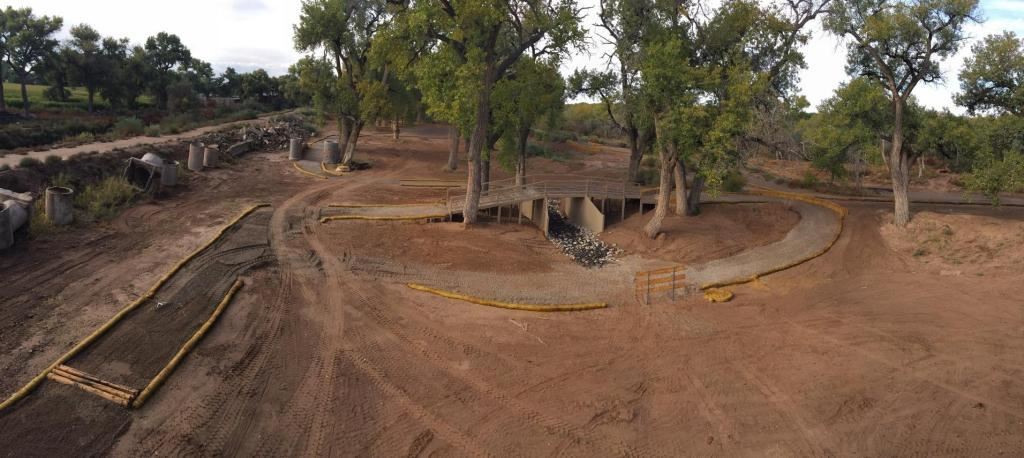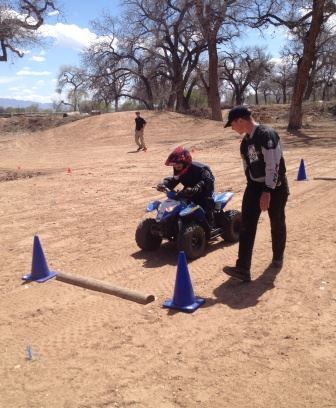Just south of Albuquerque, young off-highway vehicle (OHV) riders are having a blast.
They are maneuvering their ATVs through tight turns, over rocks and logs, into some deep sand, then under a bridge, up a hill and back over the bridge, which rattles like it was built a century ago.
But this isn’t a trail out in the desert. It’s a training course, right off Main Street in the Village of Los Lunas, NM. This unique trail is part of the Los Lunas River Park OHV Training Facility. Almost a half mile in length, it’s the only one of its kind in the state, and one of only a few in the country built to simulate real trails.

The training facility has been in operation since 2012 and features a large, flat area with a dirt hill, where the basic ATV safety training class is taught. A covered gazebo nearby is used for classroom instruction. The trail, which had its grand opening in October of 2015, is designed to simulate actual trail conditions the young riders will encounter when they venture out and ride on designated, public ATV trails or open, legal riding areas.
“After the students go through the basic ATV training class, they have the opportunity to take a couple laps on the trail,” said Chris Johnson, OHV education coordinator for the New Mexico Department of Game and Fish. “We stop at each station along the trail and focus back on what particular skill they learned during the class that is applicable to that section of the trail. Then they ride on it.”
A few challenge sections on the trail include multiple paths with varying difficulty levels. For example, a long, flat straightaway with built-in bumps has three paths. The far right path features small timbers, the middle option has larger timbers and the far left route has even larger logs buried in the ground. A bypass allows riders to avoid the challenge if they feel it is too difficult or unsuitable for a youth-sized ATV. The bypass also lets riders circle back and repeat the obstacle course at a higher difficulty level.
As they approach the bridge, riders first go under it, maneuvering over rocks much like they would when riding down a dry creek bed. Then they go up a small hill, and circle back to ride over the bridge. “The bridge is everybody’s favorite, because of the way we designed it,” said Andrew Gutierrez, park ranger with the Los Lunas Open Space Division, part of the village’s park and recreation department. “The planks make some noise and move a little, so it’s kind of a rickety feeling, but underneath it is 4-inch tubular steel. It’s very safe, but that noise and the feel, all the kids love it. It’s one of those things we put in there, hoped it would take and it did.”

The course also features a limiter gate at the starting point, similar to what riders will find at trailheads in National Forests, used to control the width of vehicles allowed on OHV trails. The course was built with features to provide training for off-highway motorcycles (OHMs) and side-by-sides. Except for some side-by-side training for law enforcement officers, training so far has been on ATVs.
Planning, building and funding the training facility and providing trained safety instructors, involved partners at all levels of government, as well as local companies and non-profit organizations, including: the Village of Los Lunas; the New Mexico Department of Game and Fish; the Middle Rio Grande Conservancy District; Reineke Construction, a member of the Professional Trail Builders Association; and the National Off-Highway Vehicle Conservation Council (NOHVCC).
What was the common ground that brought all these groups together? “The undeniable need,” said Gutierrez. “Because of the things that were happening around us, the accidents, the misuse and lack of education. And the fact that that nothing like this is in New Mexico.
“It is an amazing success story. I have to commend New Mexico Game and Fish. They came up with a very good curriculum. I am excited every time I teach it. We put kids through various scenarios to teach them how to relax on the machine and properly ride it and how your body movement influences where the vehicle goes.
“Parents of the children we’ve taught tell us that the difference in their child’s riding habits before and after the class is amazing. They are filled with happiness toward everybody that worked to create the facility.
“It’s tough to quantify results, but off the top of my head I’d say we’ve seen a 90 percent reduction of misuse of the vehicles in our community. It used to be a daily thing for us to deal with someone on an OHV and now it practically doesn’t exist.
“It’s only because of the partnership between all the groups and the hard work they put into the facility.”

